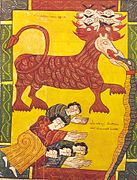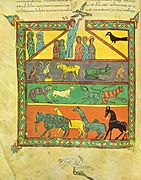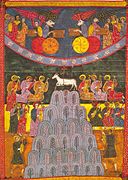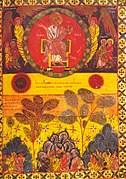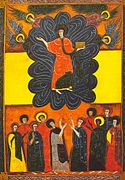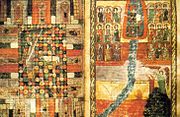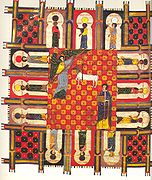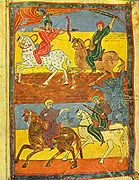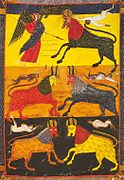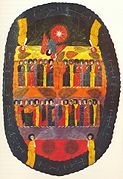Commentary On The Apocalypse
Commentary on the Apocalypse (Commentaria in Apocalypsin) is a book written in the eighth century by the Spanish monk and theologian Beatus of Liébana (730–785) and copied and illustrated in manuscript in works called Beati during the 10th and 11th centuries AD.
This article needs additional citations for verification. (June 2013) |
It is a commentary on the New Testament Apocalypse of John or Book of Revelation. It also refers to any manuscript copy of this work, especially any of the 27 illuminated copies that have survived. It is often referred to simply as the Beatus. The historical significance of the Commentary is made even more pronounced since it included a world map, which offers a rare insight into the geographical understanding of the post-Roman world. Well-known copies include the Morgan, the Saint-Sever, the Gerona, the Osma and the Madrid (Vitr 14-1) Beatus codices.

Considered together, the Beatus codices are among the most important Spanish manuscripts and have been the subject of extensive scholarly and antiquarian enquiry. The illuminated versions now represent the best known works of Mozarabic art, and had some influence on the medieval art of the rest of Europe.
The Commentary on the Apocalypse (Commentaria in Apocalypsin)
The work consists of several prologues (which differ among the manuscripts) and one long summary section (the "Summa Dicendum") before the first book, an introduction to the second book, and 12 books of commentary, some long and some very short. Beatus states in its dedication to his friend Bishop Etherius that it is meant to educate his brother monks.
The work is structured around selections from previous Apocalypse commentaries and references by Ticonius (now mostly lost), St. Primasius of Hadrumetum, St. Caesarius of Arles, St. Apringius of Beja, and many others. There are also long extracts from the texts of the Fathers of the Church and Doctors of the Church, especially Augustine of Hippo, Ambrose of Milan, Irenaeus of Lyons, Pope Gregory I, Saint Jerome of Stridon, and Isidore of Seville. Some manuscripts add commentaries on the books of Ezekiel and Daniel by other authors, genealogical tables, and the like, but these are not strictly part of the Beatus.
The creative character of the Commentary comes from Beatus' writing of a wide-ranging catena of verses from nearly every book of the Bible, quotes of patristic commentary from many little known sources, and interstitial original comments by Beatus. His attitude is one of realism about church politics and human pettiness, hope and love towards everyday life even when it is difficult, and many homely similes from his own time and place. (For example, he compares evangelization to lighting fires for survival when caught far from home by a sudden mountain blizzard, and the Church to a Visigothic army with both generals and muleskinners.) His work is also a fruitful source for Spanish linguistics, as Beatus often alters words in his African Latin sources to the preferred synonyms in Hispanic Latin.
The message

The Kingdom of Toledo fell in 711, leaving most of the Iberian Peninsula in the hands of Muslim conquerors. Christians under Pelayo managed to establish one kingdom on the northern coast, protected by the Cantabrian Mountains. Beautus lived in the Cantabrian valley of Liébana. With the recent conquest of the Iberian Peninsula, the Apocalypse and the symbolism in it took on a different meaning. The beast, which had previously been believed to represent the Roman Empire, now became the Caliphate, and Babylon was no longer Rome, but Córdoba.
In continuity with previous commentaries written in the Tyconian tradition, and in continuity with St. Isidore of Seville and St. Apringius of Beja from just a few centuries before him, Beatus' Commentary on the Apocalypse focuses on the sinless beauty of the eternal Church, and on the tares growing among the wheat in the Church on Earth. Persecution from outside forces like pagan kings and heretics is mentioned, but it is persecution from fellow members of the Church that Beatus spends hundreds of pages on. Anything critical of the Jews in the Bible is specifically said to have contemporary effect as a criticism of Christians, and particularly of monks and other religious, and a good deal of what is said about pagans is stated as meant as a criticism of Christians who worship their own interests more than God. Muslims are barely mentioned, except as references to Christian heresies include them. Revelation is a book about the Church's problems throughout all ages, not about history per se. In the middle of Book 4 of 12, Beatus does state his guess about the end-date of the world (801 AD, from the number of the Holy Spirit plus Alpha, as well as a few other calculations) although he warns people that it is folly to try to guess a date that even Jesus in the Bible claimed not to know.
Copies of the manuscript
There are 35 surviving copies, 27 of which are illustrated below:
Illustrated in the Iberian Peninsula
9th through 11th centuries
| Date finished | Manuscript ID | Names known as | Current repository | Other information | Links to image archives | Example image | Illustrator |
|---|---|---|---|---|---|---|---|
| 9th century AD | unknown | Nájera fragment | unknown | Probably associated with the abbey of Santo Domingo de Silos | Unknown | ||
| Circa 920–930 | Ms. 33 | Beatus of San Millán de la Cogolla. | Real Academia de la Historia, Madrid | * Ms. 33 Beato de San Millan de la Cogolla. *Ms. 33 Beato de San Millan de la Cogolla. (Select images) *Ms. 33 (black and white images) | Unknown | ||
| Middle of the 10th century. Alternative dates include the end of the 9th century, 920–930 and 925–935. | Ms. Vit. 14.1 | *Beati in Apocalipsin libri duodecim. *Emilianense Codice *Beatus of San Millán) *Beatus of Liébana - Emilianense Codex) | Kept at Biblioteca Nacional, Madrid. | Vit. 14-1 Beati in Apocalipsin libri duodecim. (Emilianenses Codice) | |||
| Circa 950–955 | Ms. Cod. & II.5 | *Escorial Beatus of San Millán *Beatus of the monastery of the Escorial) | El Escorial, Real Biblioteca de San Lorenzo | 225 x 355 mm. 151 leaves; 52 miniatures. | *Ms. Cod. & II.5 Escorial Beatus of San Millán. | Unknown | |
| Circa 960 | Ms 644 | *Morgan Beatus *Beatus of San Miguel de Escalada *Beatus of the Magius) | Morgan Library (New York) | 280 x 380 mm. 89 miniatures. Some reproductions have name Pierpont attached for the Pierpont Morgan Library. | *Ms 644 Morgan Beatus. Click on image to access all pages. | Illustrated by Magius, archipictor. | |
| Circa 968–970 | AHN CODICES, L.1097 | Beatus of Tábara. | Archivo Histórico Nacional | Mostly un-illustrated but some large images. | *Ms 1097 B Beatus of San Salvador de Távara. Click on image to access all pages. * AHN CODICES,L.1097 Beatus of Tábara | Magius (finished by his apprentice Emeterio at the Monastery of Tábara, Zamora.) | |
| Circa 970 | Ms. 433 (ex ms 390) | Beatus of Valcavado. | Valladolid. Biblioteca de la Universidad | 97 miniatures extant | *Ms. 433 Beatus of Valcavado Click on image to access all pages. | Painted by Oveco for the abbot Semporius. | |
| Circa 975 | Ms. 7 | *Gerona Beatus Beatus of Gerona Beatus of Távara | Held at the Cathedral of Girona. Archives. | 260 x 400 mm. 280 leaves. 160 miniatures | Ms. 7 Gerona Beatus (Girona Beatus) Click on image to access all pages. | Painted by Emeterius (pupil of Magius) and by the nun Ende. | |
| Circa 975 | Ms. 26 | *Beatus of La Seu d'Urgell. *Urgell Beatus of Rioja or León *Beatus of the Cathedral of Urgell) | Held at the archives of the Cathedral of La Seu d'Urgell | 90 miniatures | *Ms. 26 Urgell Beatus. Click on image to access all pages. | Illustrator unknown | |
| 1047 | Ms. Vit. 14.2 | *Beatus of Liébana *Beatus of León *Beatus of Facundo *Beato of Facundus *Beatos de la Biblioteca Nacional de España Beato de Fernando I y doña Sancha | Held at Biblioteca Nacional, Madrid. | Made for Ferdinand I and Queen Sancha. 267 x 361 mm. 312 leaves. 98 miniatures. | *VITR 14.2 (pdf)Beato of Liébana: Codice of Fernando I and Dña. Sancha. (Facundo/Facundus) | Illustrated by Facundo/Facundus | |
| Circa 1086 | Cod. 1 | *Beatus of Burgo of Osma. *Beatus of Liébana - Burgo de Osma Codex | Kept at the library of the Cathedral of Burgo de Osma. | 225 x 360 mm. 166 folios. 71 thumbnails. | Scribe: Petrus. Painter: Martinus. | ||
| 1091–1109 | Add MS 11695 | *Beatus of Santo Domingo de Silos | London. British Library | * Add MS 11695 British Library access to Beatus of Santo Domingo de Silos. * Add MS 11695 Beatus of Santo Domingo de Silos. Click on image to access all pages. | |||
12th and 13th centuries
- Beatus of Navarra. (Beatus of Liébana - Navarra Codex). Circa 12th century, 60 illuminations. Kept at Bibliothèque Nationale de France, Paris. Ms. Nouv. Acq. Lat. 1366
- Beatus of Turin. (''Beato de Turín) (Beatus of Liébana - Turin Codex) Held at Biblioteca Nazionale Universitaria, Turin. J.II.1 (olim lat.93). 214 folios, 360 x 275 mm, 106 miniatures Date of creation unknown. 12th century.
- Rylands Beatus [R]: Manchester, John Rylands Library Latin MS 8), ca. 1175.
- Cardeña Beatus. (Beatus of San Pedro de Cardeña). (códice del Monasterio de San Pedro de Cardeña, Burgos). Ca. 1180. Document split up; many pages unaccounted for. Currently accounted for folios are dispersed between collections in 1) Museo Arqueológico Nacional in Madrid Ms. 2. (127 folios), 2) Metropolitan Museum of Art in New York (15 folios), 3) the private collection of Francisco de Zabálburu y Basabe (2 folios), 4) Museu d’Art de Girona in Girona (1). A facsimile edition by M. Moleiro Editor has gathered them all to recreate the original volume as it was. The Museo Arqueológical Nacional reports that the Diocesan Museum of Gerona has a folio and the Collection Heredia-Spínola of Madrid has a folio-and a-half.
- Beatus of Lorvão [L] written in 1189 in the monastery of St Mammas in Lorvão (Portugal); Arquivo Nacional da Torre do Tombo in Lisbon.
- Beatus of Las Huelgas. (Beatus of Liébana - Huelga Codex). Circa 1220. 90+ miniatures, kept at The Morgan Library & Museum, New York. M. 429 Produced in royal monastery of Las Huelgas, probably commissioned by the queen Berengaria of Castile, sister of Alfonso VIII. (Not the Morgan Beatus, see above)
- Arroyo Beatus Copied 1st half of the 13th century, c. 1220 in the region of Burgos, perhaps in the monastery of San Pedro de Cardeña. Paris (Bibliothèque nationale) NAL 2290 and New York (Bernard H. Breslauer Collection).
- Beatus of San Salvador de Távara. Ca. 968 / 970. Madrid. Archivo Historico Nacional. Ms 1097 B (1240). Painted by Magius, finished after his death by his pupil Emeterius.
Not illustrated
- Beatus of Alcobaça. ALC. 247 Not illustrated.
- Beato ACA. Not Illustrated.
- Beato de Sahagún. Fragments. Not illustrated.
Copied in South Italy
- Genevan Beatus. Kept at the Bibliothèque de Genève. 'Ms. lat. 357. Circa mid-to-late eleventh century. Originated in South Italy, Beneventan region. 97 Folios in 13 books.
- Berlin Beatus. (Beatus of Liébana, Berlin Codex). (Beatus Commentary written in Carolingian script with Beneventan notations).Kept in Staatsbibliothek, Preußischer Kulturbesitz, Berlin. Ms. theol. lat. fol. 561 12th century. 98 Folios One of three Beatus manuscripts made outside Iberian Peninsula.
- Beneventan Beatus fragment. Kept at Milan, Archivio di Stato Rubriche, Notarili 3823, fol. 2v.
Copied in Southwestern France
- Saint-Sever Beatus. (Beatus of Saint-Sever). Illustrated by Stephanus Garsia (and other unnamed). Kept at the Bibliothèque Nationale de France, Paris. C. 1038. Alternate dates include 1060–1070. Ms. Lat. 8878.
Influence
The Commentary on the Apocalypse strongly influenced the Guernica of Picasso.
Gallery
- Escorial Beatus, f. 108v: Worship of the beast and dragon
- Osma Beatus, f. 139: The Frogs
- Facundus Beatus, f. 191v: The Dragon gives his power to the Beast
- Urgell Beatus, f. 82v: Noah's Ark
- The world map from the Saint-Sever Beatus measuring 37 X 57 cm. This was painted c. 1050 as an illustration to Beatus' work at the Abbey of Saint-Sever in Aquitaine, on the order of Gregori de Montaner, Abbot from 1028 to 1072
- Valladolid Beatus, f. 120: The Angel of the Fifth Trumpet: "And the fifth angel sounded, and I saw a star fall from heaven unto the earth: and to him was given the key of the bottomless pit" (Revelation, 9.1)
- Facundus Beatus, page 410: Adoration of the Mystical Lamb on Mount Zion: A lamb stood on the Mount Zion and to one-hundred-forty-four thousand, having cytharas
- Facundus Beatus, f. 224 (detail): "And the woman was arrayed in purple and scarlet, and decked with gold and precious stone and pearls, having in her hand a golden cup full of abominations, even the unclean things of her fornication, and upon her forehead a name written: «Mystery, Babylon the Great, the mother of the harlots and of the abominations of earth.»" (Revelation, 17.4–5)
- Facundus Beatus, f. 186v: "And there appeared a great wonder in Heaven; a woman clothed with the sun, and the moon under her feet, and upon her head a crown of twelve stars: And she being with child cried, travailing in birth, and pained to be delivered. And there appeared another wonder in Heaven; and behold a great red dragon, having seven heads and ten horns, and seven crowns upon his heads" (Revelation, 12.1–3)
- Morgan Beatus, f. 112: The opening of the Sixth Seal: "And I beheld when he had opened the sixth seal, and, lo, there was a great earthquake; and the sun became black as sackcloth of hair, and the moon became as blood" (Revelation, 6.12)
- Facundus Beatus, f. 6v: "I am Alpha and Omega, the beginning and the ending, saith the Lord, which is, and which was, and which is to come, the Almighty." (Revelation, 1.8)
- Facundus Beatus, f. 240: "And I saw heaven opened, and behold a white horse; and he that sat upon him was called «Faithful» and «True», and in righteousness he doth judge and make war. His eyes were as a flame of fire, and on his head were many crowns; and he had a name written, that no man knew, but he himself. And he was clothed with a vesture dipped in blood: and his name is called The Word of God." (Revelation, 19.11–13)
- Osma Beatus, f. 151 The victorious Christ
- Urgell Beatus, f. 209 (detail): Siege of Jerusalem by Nebudchadnezzar
- Facundus Beatus, f°43v, The great Theophany
- Urgell Beatus, f°198v–199 The new Jerusalem, the river of life
- Facundus Beatus, f°253v The new Jerusalem
- Beatus de Valladolid, f°93 The four horsemen
- Facundus Beatus, f°135 The four horsemen
- Facundus Beatus, f°171v The monstrous beasts
- Facundus Beatus, f°145 The elect and the angels restraining the winds
Notes
References
- O'Neill, John P., ed. (2003). The Art of Medieval Spain, 500–1200. New York: The Metropolitan Museum of Art.
- The Illustrated Beatus: a corpus of the illustrations of the commentary on the Apocalypse by John Williams. 5 Volumes. Harvey Miller and Brepols, 1994, 1998, 2000. Art books attempting to document all the Beatus illustrations in all surviving manuscripts. Due to expense, most illustrations are reproduced in black and white. Unfortunately, Williams was uninterested in Beatus' text, and thus spread some misconceptions about it, but his art scholarship and tenacity are amazing. His books' influence on most of this Wikipedia article is strong.
- Castro Correa, Ainoa (2020). "The scribes of the silos apocalypse (London, British library, add. MS 11695) and the scriptorium of silos in the late eleventh century". Speculum. 95 (2): 321–370. doi:10.1086/707906. hdl:10366/155075.
Further reading
- Commentarius in Apocalypsin. Ed. Henry A. Sanders. Papers and monographs of the American Academy in Rome 7 (Rome: American Academy in Rome, 1930). The first critical edition of the commentary. Latin.
- Beati Liebanensis Tractatus de Apocalipsin. Ed. Roger Gryson. Corpus Christianorum: Series Latina 107 B-C (Turnhout: Brepols, 2012). Two volumes of a new, improved and up-to-date critical edition of the commentary's text. Latin and French.
- Commentary on the Apocalypse - Part I. Trans. M.S. O'Brien. (2013). English translation of Books I and II. Includes many sources and quotes not noted in Gryson.
External links
- "Beato de Liébana: códice de Fernando I y Dña. Sancha". World Digital Library (in Latin and Spanish). Retrieved 2014-03-01.
- In Apocalypsin, 1770 edition of the Commentary. Latin.
- A selection of the most relevant Beatus, advertisement for facsimile editions
- Illuminations of Beatus
- Works of Beatus
- Miniatures from the Rylands Beatus
Links to specific manuscripts
- Arroyo Beatus
- Arroyo Beatus Archived 2017-01-04 at the Wayback Machine Another way to view
- Ms. 33 Beato de San Millan de la Cogolla.
- Ms. 33 Beato de San Millan de la Cogolla. (Select images)
- Ms. 33 (black and white images)
- Ms. Cod. & II.5 Escorial Beatus of San Millán.
- Ms 644 Morgan Beatus. Click on image to access all pages.
- Ms 1097 B Beatus of San Salvador de Távara. Click on image to access all pages.
- AHN CODICES,L.1097 Beatus of Tábara
- Códice 44 Beato de Lorvão
- Ms. 433 Beatus of Valcavado Click on image to access all pages.
- Ms. 26 Urgell Beatus. Click on image to access all pages.
- Ms. 7 Gerona Beatus (Girona Beatus) Click on image to access all pages.
- Vit. 14-1 Beati in Apocalipsin libri duodecim. (Emilianenses Codice)
- VITR 14.2 (pdf)Beato of Liébana: Codice of Fernando I and Dña. Sancha. (Facundo/Facundus)
- Add MS 11695 British Library access to Beatus of Santo Domingo de Silos.
- Add MS 11695 Beatus of Santo Domingo de Silos. Click on image to access all pages.
- Ms. lat. 357 Geneva Beatus.
- MS 8 Rylands Beatus (select images)
- Ms. 2. Cardeñas Beatus Some of the 135 folios online at the Museo Arqueólogico Nacional
- Cardeñas Beatus 15 folios at the Metropolitan Museum of Art
- ALC. 247 Beatus of Alcobaça. Not illustrated.
- Beato ACA Not Illustrated.
- Beato de Sahagún Not illustrated.
- MS 429 Huelgas Apocalypse
- MS 429 Huelgas Apocalypse
This article uses material from the Wikipedia English article Commentary on the Apocalypse, which is released under the Creative Commons Attribution-ShareAlike 3.0 license ("CC BY-SA 3.0"); additional terms may apply (view authors). Content is available under CC BY-SA 4.0 unless otherwise noted. Images, videos and audio are available under their respective licenses.
®Wikipedia is a registered trademark of the Wiki Foundation, Inc. Wiki English (DUHOCTRUNGQUOC.VN) is an independent company and has no affiliation with Wiki Foundation.
